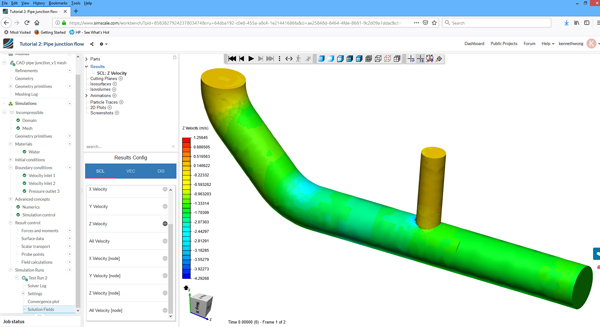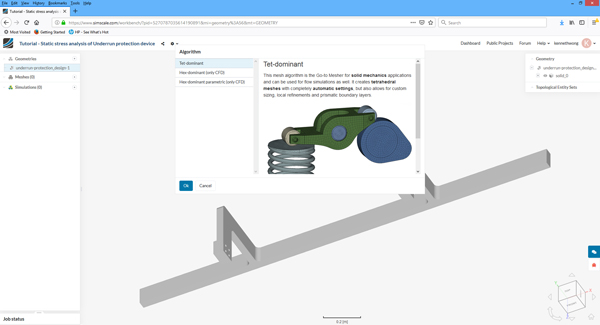
SimScale’s SaaS-style CFD simulation interface, showing completed run results.
Latest News
January 11, 2019
Part of the growing trend to make simulation more accessible and affordable, SimScale delivers its products the SaaS (Software as a Service) model, allowing you to run simple simulation sessions through the browser.
SimScale offers free, professional, and enterprise subscriptions at different pricing. The free subscription doesn't allow you to save private projects. As such , it is intended for open source and hobbyist projects. The free subscription is also capped at 3,000 computing core hours per year, with up to 16 computing cores. By contrast, the professional subscription offers unlimited private projects, unlimited parallel runs, and up to 96 computing cores. The company doesn't publish pricing for professional and enterprise accounts; details are available on inquiry.
With the free account, you get access to fluid, thermal, and structural mechanics solvers, covering the majority of basic simulations conceivable in the conceptual phase. The site provides three easy-to-follow tutorials, one for each type of the solver. The newly introduced GPU-accelerated Pacefish solver, however, is available only to paid subscribers.
 .
.
 .
.
The interface is simple, straightforward. The recommended approach is to first initiate the meshing process (which can take a few minutes for free users), then proceed to set up the simulation. The simulation tree in the left pane gives a list of items to complete before running simulation: material assignment, boundary conditions, and so on.
As you click on different simulation choices (turbulence models, mesh types, simulation domains, for example), you get a brief description of what each is useful for. This guidance is helpful to novices and users with limited simulation experience.
When the required steps are in completed (marked with green checkmarks in the simulation tree), you can initiate the simulation. Once completed, the site send you an email notice to let you know it's completed. The results can be viewed online, straight from the browser.
The interface might be further improved with some visual clues that represent the boundary conditions (for example, downturn arrows with specific values for pressures applied on a surface). As it is, you have to click on the boundary condition tree and open up the dialog box to see precisely what has been applied. While it's easy to keep track of the boundary conditions in simple setups, it could get too complex to easily remember in larger simulation jobs.
For more, check out the video review at the top of the page.
For More Info
Subscribe to our FREE magazine, FREE email newsletters or both!
Latest News
About the Author
Kenneth Wong is Digital Engineering’s resident blogger and senior editor. Email him at [email protected] or share your thoughts on this article at digitaleng.news/facebook.
Follow DE





